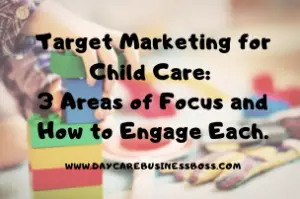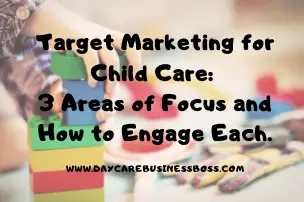One of the most challenging aspects of running a child care center is making sure it is visible to the right people. Understanding how your child care center will be seen by the messaging you put out and who are the people that need to see it are two very critical pieces of knowledge for your success. We have compiled three areas you will need to address when developing your marketing strategies.
Here are the 3 areas for developing strategies for target marketing a childcare/daycare business:
#1 Target Audience
#2 Tools
#3 Engagement
1. Target Market
There are three elements we need to understand first when determining your child care center’s target market. The first element will be defining your offerings; then, you will need to identify families in proximity to your child care center and determine your primary and secondary market strategies.
Offering
Your child care center will vary its audience compared to others depending on what you offer. Offerings can be what differentiate you from other centers and essential  for understanding when marketing. Your goal is to connect what you do well to what someone needs today. For example, if you offer full-time child care, your target audience may be parents who have children below 5 years old. The need for all around the clock child care is higher around these ages. If you want to care for older children, then offering after school services will be essential to meeting that goal.
for understanding when marketing. Your goal is to connect what you do well to what someone needs today. For example, if you offer full-time child care, your target audience may be parents who have children below 5 years old. The need for all around the clock child care is higher around these ages. If you want to care for older children, then offering after school services will be essential to meeting that goal.
Proximity
When assessing your target market, determine within a 5-mile radius, what the family demographics are. Most families will not want to travel more than 5 miles to drop their child off. According to NSECE, on average, families will travel 4.6 miles if their children are three years old and below. Families with children between 3- to 5-years average about 3.9 miles. After identifying what family types are in proximity to your child care center, it is time to look at what families are the majority.
If your offerings meet the family types within the 5-mile radius, then it would appear your child care center is positioned well for success. However, if most family types are children with five-year-old children or above, you offer full-time service. You may want to rethink your offering to prevent wasting money on full-time staff if there is no demand for full-time child care.
Another strategy may be to find a new location that does need the offerings you want to provide, for example, moving into an area with families in a 5-mile radius who have children ages three and below. This situation would demand a full-time child care service; when thinking of location, research your competition who may also be within the range of your child care center.
Break Down
You can break it out into two categories. These categories, according to Childcaremarketing.com, are the primary and secondary markets. The primary market will be determined by what families in your area fit your services. Suppose you already have an existing child care center with current demographics you can pull data. In that case, identifying the typical family, you care for will determine this primary market without looking outside your child care center.
 Your secondary target market will be those families who are not considered the primary customer or best customer. Your secondary target market does not mean they are not equally important. They still make up the percentages of your entire revenue for keeping the doors open.
Your secondary target market will be those families who are not considered the primary customer or best customer. Your secondary target market does not mean they are not equally important. They still make up the percentages of your entire revenue for keeping the doors open.
When thinking about reaching your secondary target market, it will be less about marketing campaigns that stretch over long periods of time and more about using modified methods of reaching those parents with advertising techniques. These techniques may include messaging, graphics, lower budget, and using digital media specific to the secondary target audience.
Overall, you will want to keep an eye on your marketing data, returns, where families hear about you, why they decided to choose you over someone else, and more. Answering these questions with data can help you tweak your existing marketing strategies for more successful returns in the future.
2. Tools
You have done all the research and identified your primary and secondary target markets. You are confident in your abilities to serve them, and you offer what they need. Now, what tools will you decide to use for reaching out to them?
Social Media
These digital platforms have become entirely known by now; examples are Facebook, LinkedIn, Instagram, TikTok, Snapchat, etc. They are readily available, easy-to-use, and usually, people interested in what you do are already trying to connect with you. These tools will help achieve a high level of engagement between you and your target market. It keeps you in their mind as they browse their feeds and relate to your messages.
The challenges of social media are going to be around time dedication. You will be demanded to build content and maintain your followers’ attention. Many companies market using social media, creating an environment fraught with overstimulation. The best you can do is find your voice and not be hesitant in speaking to the future of childcare and how you are managing their children’s quality of life while in your care.
Website
Building a website may go without saying, but I will say it. Your families deserve a place they can visit for critical information and updates. Your website is your child  care’s digital hub for all you, your team, and your children. Without a website, you will not have a robust digital presence, which creates ambiguity to your identity as a child care center, especially in the digital age.
care’s digital hub for all you, your team, and your children. Without a website, you will not have a robust digital presence, which creates ambiguity to your identity as a child care center, especially in the digital age.
On your website, you will want to set up messaging that speaks to your primary target market. Chron.com suggests including search engine optimization terms for parents in your target market. Also, link your social media channels to the website to perform further research without finding the streams using their methods.
Keeping people engaged in your digital network is vital as will decrease the chance of them going elsewhere.
Never forget email marketing. On your website, there should be a way for people to ask about your services. This contact card or contact feature will catalog their email into your database so you can blast out emails with one click. Your emails should be personable to your primary market. Inform them of what you are doing, how your child care is working with their children, what events you might have coming up, and if there are changes, explain why. Emails act as a more direct and personal way to converse with your families and potential families. They allow them to feel apart of the organization, get an inside look while still being outside, and how you approach them will show your level of commitment to their child’s unique needs.
Parenting Magazine
Identify local magazines and newspapers which will have data on their demographics, especially parenting magazines. If you can find a parenting magazine or a newspaper that reaches your primary target market, it may be worth purchasing a small ad.
Check out our tips for promoting your daycare successfully HERE!
3. Engagement
You have identified how to connect your offerings with your primary and secondary market needs. You have built out social media strategies, built out a website, bought a small space for advertising in a magazine or newspaper, and families are contacting you  through email. Your visibility and presence are becoming felt across the community you wanted. Now you must work at keeping that community engaged with your services. Keeping your target market engaged will require a content strategy.
through email. Your visibility and presence are becoming felt across the community you wanted. Now you must work at keeping that community engaged with your services. Keeping your target market engaged will require a content strategy.
Content strategies refer to the planning, development, and management of content. You want to keep the attention of your families so that they do not look elsewhere. If it is challenging to balance the physical demands and digital demands in the digital age, hiring a content manager who acts as a social media manager may be necessary. Their job is to engage your families wherever you need them across your digital network.
More engagement delivered means the more families might speak about your child care’s reliability to other families. The goal is to establish a wide presence that can open new opportunities to upgrade, expand, and build out your child care center’s quality of care to other families who deserve someone like you to be as passionate about their children as they are.
Identify local magazines and newspapers which will have data on their demographics, especially parenting magazines. If you can find a parenting magazine or a newspaper that reaches your primary target market, it may be worth purchasing a small ad.
Related Questions
What is the cost of social media marketing?
The average cost of social media advertising ranges from $15 to $200 per day or $450 to $6,000 per month. Instagram’s market price will be around $1 per day for impressions and $5 per click, likes, or views, and $40 per day for app installs or offer claims. YouTube is $10 per day, with LinkedIn at $2 per click/$10 per day, and Facebook setting their pricing the same as Instagram. Additionally, there is Pinterest, which sits at $2 per impression and $0.10 for clicks. You can find this pricing on webfx.com for further details.
How much does content or social media management cost?
Content manager salaries can be anywhere between $39K to $78K annually. The social media manager will range from $150 per month to $400 per month. According to deluxe.com, fundamental social media management at the lower end of the spectrum with more advanced work at the higher end.
What are some other questions I need to answer for market research?
Is there a desire for your child care center or child care services?
How many families fit your offerings?
What are some economic indicators of those families?
Where will you be locating your services?
How many other options for child care like your own within the area?
How much do families pay for those alternative child care options?

Please note: This blog post is for educational purposes only and does not constitute legal advice. Please consult a legal expert to address your specific needs.
To learn more on how to start your own daycare checkout my startup course and documents here.

Meet Shawn Chun: Entrepreneur and Childcare Business Fan.
I’m a happy individual who happens to be an entrepreneur. I have owned several types of businesses in my life from a coffee shop to an import and export business to an online review business plus a few more and now I create online daycare business resources for those interested in starting new ventures. It’s demanding work but I love it. I do it for those passionate about their business and their goals. That’s why when I meet a childcare business owner, I see myself. I know how hard the struggle is to retain clients, find good employees and keep the business growing all while trying to stay competitive.
That’s why I created Daycare Business Boss: I want to help childcare business owners like you build a thriving business that brings you endless joy and supports your ideal lifestyle.



1 thought on “Target Marketing for Child Care: 3 Areas of Focus and How to Engage Each.”
Comments are closed.